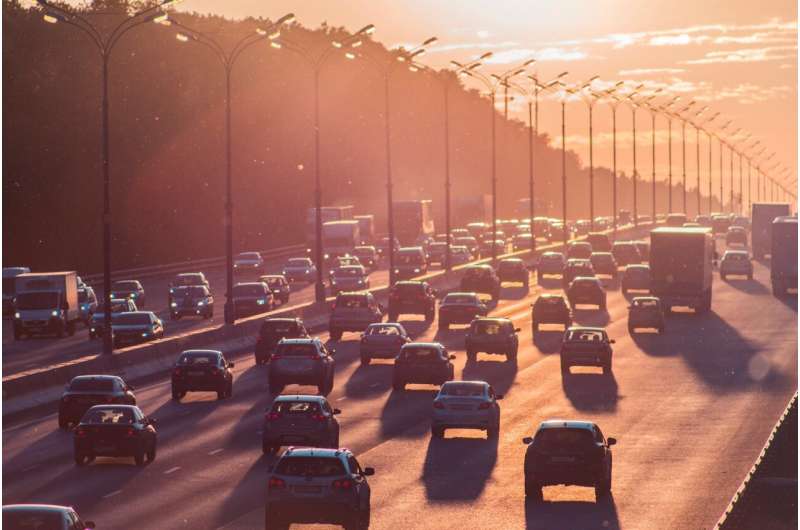This article has been reviewed according to Science X's editorial process and policies. Editors have highlighted the following attributes while ensuring the content's credibility:
fact-checked
reputable news agency
proofread
New pollution rules could improve air quality in Bay Area, other parts of California

In a significant move aimed at reducing some of the most harmful types of air pollution in the country, the U.S. Environmental Protection Agency has set tougher standards for fine particulate matter, or soot, saying they would save thousands of lives nationwide.
Several Bay Area counties—Santa Clara, Alameda, and Contra Costa—are expected to be out of compliance under the new rules, including large parts of the Central Valley and Southern California.
The new national standards, which were endorsed by health and environmental groups and criticized by the oil, manufacturing and other industries, are expected to mean stricter rules for oil refineries, factories and power plants, along with diesel-powered vehicles and other emissions sources.
Particulate pollution can lodge deep in the lungs of people who regularly breathe it, increasing the risk of asthma, cancer, heart attacks and other ailments. The risk is particularly high in low-income communities located near ports, freeways, power plants, factories and rail yards.
On Wednesday, the EPA said the new rules would prevent up to 4,500 premature deaths and 290,000 lost workdays, yielding up to $46 billion in net health benefits by 2032. For every $1 spent to comply with the rules nationwide, up to $77 in human health benefits would accrue by in 2032, the agency said.
"This final air quality standard will save lives and make all people healthier, especially within America's most vulnerable and overburdened communities," said EPA Administrator Michael Regan. "Cleaner air means that our children have brighter futures, and people can live more productive and active lives, improving our ability to grow and develop as a nation."
Industry groups said the rules will add costs and regulations, and could limit job growth.
"Today's announcement is the latest in a growing list of short-sighted policy actions that have no scientific basis and prioritize foreign energy and manufacturing from unstable regions of the world over American jobs, manufacturing, and national security," said Will Hupman, vice president of the American Petroleum Institute. "As we review the final standard, we will consider all our options."
The rules were last updated in 2012 by the Obama administration. The tighter rules were embraced by the Biden administration after the Trump administration rejected them in 2018.
Environmental groups on Wednesday called them a major advance.
"The EPA is putting public health first by requiring polluters to cut soot from the air we all breathe," said Manish Bapna, president of the Natural Resources Defense Council. "This will help save lives today and improve the health of generations to come."
The main state agency overseeing air quality in the Bay Area also endorsed the new rules Wednesday.
"The stronger standard will drive additional health protections for Bay Area residents, particularly those living in communities disproportionately impacted by air pollution," said Philip Fine, executive officer of the Bay Area Air Quality Management District.
Smog and other types of air pollution have declined significantly in the decades since President Richard Nixon signed the Clean Air Act in 1970 and former California Gov. Ronald Reagan established the California Air Resources Board in 1967.
Particulate pollution has fallen 42% nationwide since 2000, according to EPA data, largely due to regulations such as requiring scrubbers on smokestacks at factories and power plants, cleaner blends of gasoline and diesel fuel for cars and trucks, tougher standards on engines and other federal and state rules.
California has gone farther than other states, requiring diesel trucks to have smog checks, regulating pollution from large ships and locomotives, and requiring the owners of old semi-trucks to replace their engines. The state also has offered industries financial help to upgrade engines and other polluting equipment, funded by a $2 fee on vehicle registrations.
Soot pollution also is known as PM2.5— for particulate matter 2.5 microns or smaller, so small that 30 of the particles can line up across the width of a human hair.
The current annual health standard for such pollutants is 12 micrograms per cubic meter. Under the new rules, it will fall to 9. The EPA's scientific advisory panel recommended that EPA tighten the annual standard to between 8 to 10.
A growing source of soot pollution in the West is from wildfires. The EPA rules allow states to request exemptions from the rules when wildfires spike soot levels, on the grounds that they are "exceptional events."
During the process to develop the rules, questions arose about whether they could hurt President Joe Biden's re-election chances in key industrial states such as Michigan and Pennsylvania.
Reagan, the EPA chief, said in a call with reporters that industry has used technology to comply with improved air quality rules in the past, and that since 2000, the U.S. economy has grown 52%, even as air pollution rules have tightened, improving public health.
2024 MediaNews Group, Inc. Distributed by Tribune Content Agency, LLC.




















